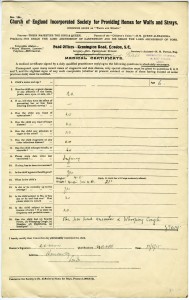Sometimes in The Children’s Society Archive you come across things that you weren’t quite expecting. In the comments to the post about diphtheria we’ve been discussing the weight and height of children 100 years ago. Spurred on, I decided to do some research of my own. The results I found were a little surprising.
From 1911 onwards a detailed medical form was created for every child who was taken into the care of The Children’s Society (then known as the Waifs and Strays Society). The forms were filled in before the children came into care so that The Children’s Society could see if they needed any immediate medical treatment. An example form is shown below (click the image to see a larger version):
Question number 12 on the form asks for the child’s weight and height. As we know the date the medical forms were created and the date the children were born, this makes it possible to calculate their body mass index (BMI).
I picked out ten case files for children who came into the care of The Children’s Society in 1912 and used the NHS’ BMI calculator to work out the BMI for each of them. My results are below:
Irene – age 11
BMI in the 6th percentile
Norah – age 13
BMI in the 8th percentile
William – age 13
BMI in the 10th percentile
Ronald – age 10
BMI in the 20th percentile
Edith – age 9
BMI in the 45th percentile
Stephen – age 6
BMI in the 52nd percentile
Arthur – age 4
BMI in the 62nd percentile
John – age 8
BMI in the 69th percentile
Ada – age 13
BMI in the 71st percentile
William – age 5
BMI in the 91st percentile
According to the NHS calculator, all of the children were at a healthy weight except for William, age 5, who is classed as overweight. However, if we take a look at the BMI charts from the Royal College of Paediatrics and Child Health, we see that these charts would class both Irene and Norah as having low BMI, being below the 9th percentile.
What does this all mean? Well, I have to admit that I was surprised. For children that came into care in 1912, I was expecting far more than 20% to have a low BMI and be underweight, and I certainly wasn’t expecting any of the children to come out as overweight!
Firstly, I have to acknowledge that my sample was very small. If I had looked at 100 or 1000 files instead of 10, I may perhaps have come to a different conclusion.
As it is, I had to have a look into Irene, Norah and William’s backgrounds to see if there was anything there that might account for their BMI.
Irene, at age 11, was living with her mother. Her parents had separated due to her father’s drinking. Trying to find work, Irene’s mother had moved to London, where she and Irene were staying temporarily with a friend. Job hunting, however, was not easy. With no job and no way to provide for the family, the only option was be for Irene to be taken into care.
Norah, at age 13, was living with her parents and two siblings, with both of her parents in regular work. Norah had been found stealing twice and so was committed by a police court to go to an industrial school for rehabilitation. What Norah had been found stealing and why is not known, but considering that she had a low BMI, poverty and a lack of food may well have had something to do with it.
William, meanwhile, at age 5, was overweight. His parents were separated and his mother was struggling to find work. This makes William’s high BMI a little confusing until we realise that because of his mother’s unemployment, William had been taken into a foster home, where his father and a charity were paying for his upkeep. William came into the care of the Waifs and Strays Society because his foster mother was no longer able to look after him.
So there we have it: ten children and not nearly as many underweight as I would have thought. Cases of malnutrition certainly happened, amongst parents as well as their children, and we have the files detailing their stories, but just how frequent those cases of malnutrition were, we don’t yet know. Time for some more in-depth research with a larger sample of cases. Anybody out there up to the task? Do email us (Hidden-Lives-Revealed@childrenssociety.org.uk) if you are, or if you would like to use The Children’s Society Archive for any other research projects that you have in mind.

